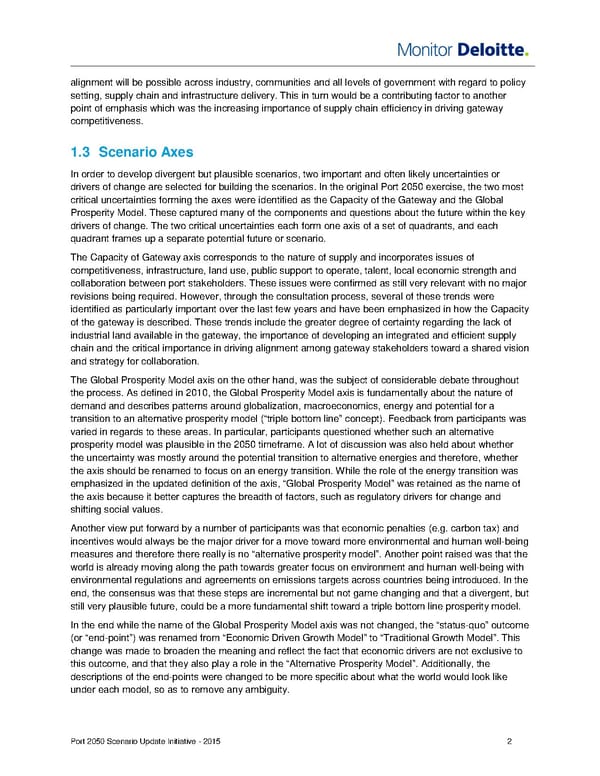alignment will be possible across industry, communities and all levels of government with regard to policy setting, supply chain and infrastructure delivery. This in turn would be a contributing factor to another point of emphasis which was the increasing importance of supply chain efficiency in driving gateway competitiveness. 1.3 Scenario Axes In order to develop divergent but plausible scenarios, two important and often likely uncertainties or drivers of change are selected for building the scenarios. In the original Port 2050 exercise, the two most critical uncertainties forming the axes were identified as the Capacity of the Gateway and the Global Prosperity Model. These captured many of the components and questions about the future within the key drivers of change. The two critical uncertainties each form one axis of a set of quadrants, and each quadrant frames up a separate potential future or scenario. The Capacity of Gateway axis corresponds to the nature of supply and incorporates issues of competitiveness, infrastructure, land use, public support to operate, talent, local economic strength and collaboration between port stakeholders. These issues were confirmed as still very relevant with no major revisions being required. However, through the consultation process, several of these trends were identified as particularly important over the last few years and have been emphasized in how the Capacity of the gateway is described. These trends include the greater degree of certainty regarding the lack of industrial land available in the gateway, the importance of developing an integrated and efficient supply chain and the critical importance in driving alignment among gateway stakeholders toward a shared vision and strategy for collaboration. The Global Prosperity Model axis on the other hand, was the subject of considerable debate throughout the process. As defined in 2010, the Global Prosperity Model axis is fundamentally about the nature of demand and describes patterns around globalization, macroeconomics, energy and potential for a transition to an alternative prosperity model (“triple bottom line” concept). Feedback from participants was varied in regards to these areas. In particular, participants questioned whether such an alternative prosperity model was plausible in the 2050 timeframe. A lot of discussion was also held about whether the uncertainty was mostly around the potential transition to alternative energies and therefore, whether the axis should be renamed to focus on an energy transition. While the role of the energy transition was emphasized in the updated definition of the axis, “Global Prosperity Model” was retained as the name of the axis because it better captures the breadth of factors, such as regulatory drivers for change and shifting social values. Another view put forward by a number of participants was that economic penalties (e.g. carbon tax) and incentives would always be the major driver for a move toward more environmental and human well-being measures and therefore there really is no “alternative prosperity model”. Another point raised was that the world is already moving along the path towards greater focus on environment and human well-being with environmental regulations and agreements on emissions targets across countries being introduced. In the end, the consensus was that these steps are incremental but not game changing and that a divergent, but still very plausible future, could be a more fundamental shift toward a triple bottom line prosperity model. In the end while the name of the Global Prosperity Model axis was not changed, the “status-quo” outcome (or “end-point”) was renamed from “Economic Driven Growth Model” to “Traditional Growth Model”. This change was made to broaden the meaning and reflect the fact that economic drivers are not exclusive to this outcome, and that they also play a role in the “Alternative Prosperity Model”. Additionally, the descriptions of the end-points were changed to be more specific about what the world would look like under each model, so as to remove any ambiguity. Port 2050 Scenario Update Initiative - 2015 2
 Monitor Deloitte - Final Report Page 3 Page 5
Monitor Deloitte - Final Report Page 3 Page 5